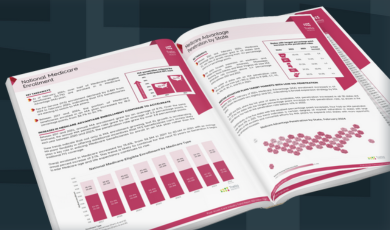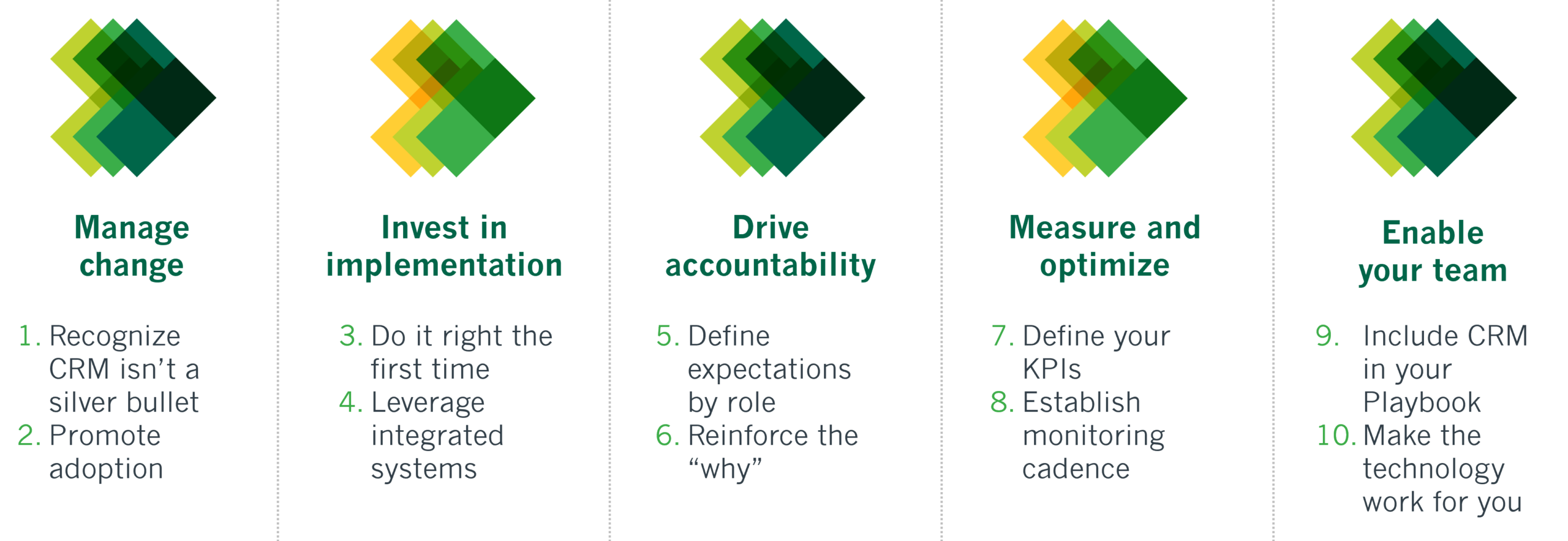In today’s competitive post-acute care industry, the successful implementation of your customer relationship management (CRM) platform is essential for your organization to thrive and stay ahead.
By developing efficient best practices – your sales team can better understand top referral sources, build stronger relationships, and become a leading referral partner – ultimately driving growth and revenue for your organization.
However, given the abundance of CRM tools and techniques available, comprehending and fully implementing every strategy in your organization can take time and effort.
In this article, we’ll explore ten CRM best practices to help you and your team optimize its CRM.
From managing change to enabling your team – these practices can help your organization connect with top referral sources and drive long-term success.
Let’s dive in and explore the top CRM best practices that can take your organization to the next level.
Manage change
1. Recognize CRM isn’t a silver bullet
A Customer Relationship Management or CRM platform is a powerful tool that can enhance your post-acute organization operations. However, it’s important to remember that it is NOT a silver bullet.
Unfortunately, simply implementing a CRM platform won’t instantly solve your problems or do the work for you. But – it can aid your organization in aligning your team and processes.
One way is to ensure everyone in your organization understands the objectives and workflows. In addition, it’s essential to define the roles and responsibilities each person will have to create a solid foundation for success.
Therefore, by leveraging the technology and integrated data provided by the CRM and ensuring everyone understands their role – you can achieve excellent execution. It’s not about using the CRM alone but how your organization utilizes it – and it takes time to understand the best way to manage it.
When you take the time to learn how the platform works and how to use it to your organization’s advantage – a CRM can become part of your everyday routine – ultimately helping you hit your targets and drive success.
2. Promote adoption
Another essential practice when it comes to CRM is promoting adoption. When promoting a CRM platform within your organization, securing executive support – and clearly communicating its purpose and goals – is a crucial step.
For example, identify enthusiastic champions or your best sales rep to endorse the CRM and inspire others in your organization.
In addition, remember to assign an internal application owner to drive the implementation and align the CRM with different roles in your organization.
Tip: Tailor the CRM messaging to highlight its benefits for each department to alleviate the fear of change and drive adoption.
Furthermore, ensure the right people are dedicated to managing and implementing your CRM with established processes in place and integrated into existing workflows.
Invest in implementation
3. Do it right the first time
When investing in a CRM platform, it’s vital to prioritize implementation and getting it right from start to finish.
Therefore, your organization must dedicate time and energy to fully understanding what your CRM is capable of and what functions you can integrate within the platform.
Before implementing, you and your team should comb through your data and ensure it is clean and accurate. For instance, remove duplicates and verify the account and contact information.
We understand it’s tedious work, but if you decide to do this process after implementation, it becomes time-consuming – resulting in a potential reimplementation or a restart entirely.
Therefore, by doing it right the first time and taking your time with implementation to ensure everything is correct – you set the foundation for a successful CRM setup that can yield long-term benefits for everyone.
4. Leverage integrated systems
As mentioned above, when implementing a CRM – it’s essential to leverage any integrated systems to enhance its capabilities and benefit your organization.
For example, explore opportunities to integrate market data insights, Electronic Health Records (EHR) , etc.
Be open to implementing additional features – even if you won’t utilize them right now.
Consider all features and ask other departments within your organization which features they might find beneficial.
By utilizing and implementing the integrated features associated with a CRM – you can uncover valuable insights and streamline processes for improved efficiency and effectiveness.
Drive accountability
5. Define expectations by role
When driving accountability regarding your CRM, your organization must define role-specific expectations off the bat.
A few non-negotiables you should establish are:
- Number of assigned accounts
- Account ranking
- Call volume and frequency
- Routing
- Activity tracking
- Account information
Utilizing a CRM as a centralized internal platform as well can help keep track of the following:
- Internal discussions
- Capturing data for account performance
- Marketing
- Strategic planning
- Expenses by account
- – and more
Tip: Ensure regular updates are performed to account information for up-to-date account data in case of rep turnover. You don’t want to take time out of your sales team’s busy day to hunt for updated addresses and account information due to a rep leaving – it’s essential to set aside time each month or quarter to check regularly.
These practices can help foster accountability and maximize CRM efficiency so you can focus on driving success.
6. Reinforce the “why.”
While implementing a CRM platform – don’t forget to include the departments that will be utilizing the CRM.
Through this process, reinforce the “why” with them to keep them engaged and drive adoption. Remind them of the overarching goals and objectives and highlight how the CRM will support and help achieve their goals.
By emphasizing the specific benefits and outcomes a CRM will deliver, you can ensure that everyone understands the purpose and importance of utilizing a CRM in their daily work.
This constant reinforcement of the “why” ensures that CRM remains a valuable tool and aligns with the organization’s strategic direction.
Measure and optimize
7. Define your KPIs
When measuring and optimizing your CRM – a great place to start is by defining your key performance indicators or (KPIs) that align with your organization’s goals.
KPIs should be:
- Clear
- Measurable
- Relevant
Utilize your CRM system to report and track KPIs to enhance visibility into performance, allowing you to make better-informed decisions.
TIP: Watch our webinar, Know Your KPIs: Key Performance Indicators to Drive Post-Acute Success, to learn how to define KPIs for your organization.
8. Establish monitoring cadence
The best way to establish an effective monitoring cadence for your CRM is to start by defining reports and metrics that leaders are held accountable for knowing.
Utilize subscriptions within the CRM to create a consistent rhythm for monitoring KPIs and goals.
For example, pay attention and look for trends and shifts in:
- Segment mix
- Length of stay (LOS)
- Payer Mix
Maintaining a consistent cadence and staying vigilant in identifying trends allows you to adapt and strategize accordingly – thus maximizing the CRM’s impact on your organization.
Enable your team
9. Include CRM in your Sales Playbook
As mentioned throughout this article, including all departments in implementing and using a CRM is essential.
To get the most benefit from your CRM – you should incorporate it into your sales playbook and sales training programs.
Your sales reps should know how to utilize the CRM and its integrated features efficiently and effectively throughout their daily routine and workflows.
Furthermore, fostering a proactive mindset among sales representatives to actively explore and leverage the features of the CRM is paramount for its success.
By empowering your team to ensure that the CRM benefits them, you establish a solid foundation for increased productivity and drive the success of your organization.
10. Make the technology work for you
Another way to excite departments about implementing a CRM is to make the technology work for them.
Below are some examples:
- Provide comprehensive training and ongoing support to ensure smooth adoption and utilization
- Promote mobile usage and allow users to access and utilize the CRM on the go
- Integrate the CRM with market insights and EHR data
- Offer incentives and rewards for CRM usage and successful utilization
- Continuously seek feedback from users to improve the CRM and address any pain points or usability issues
Gaining a comprehensive understanding of all the functionalities and possibilities offered by your CRM –and actively harnessing them to maximize value is vital.
Taking your organization to the next level
Implementing a CRM can be scary, but embracing the tool by simplifying and streamlining the process for your team will bring long-term success.
These strategies can help departments embrace and fully leverage the CRM, leading to increased efficiency, collaboration, and overall success within the organization.
Want to learn more about the benefits of a CRM?
Watch our on-demand webinar, here.















